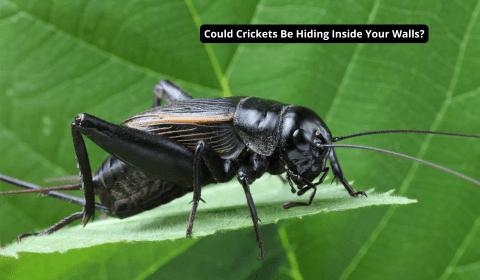Most of you are familiar with the chirping of crickets, often loud and carried by the wind on warm summer nights. What if these insects are not just hanging around your garden? What if they made their way inside your walls? Crickets entering your home creates an unsettling feeling although this occurrence proves more frequent than most people realize. The following article explains how to detect hidden crickets inside walls together with their entry points and solutions for removal.
How Do Crickets End Up Inside Your Walls?
Crickets are naturally attracted to warm and dark places, which is why your walls can be an attractive place for them. They can get inside your house through small cracks and gaps both in and around windows, doors, or foundations. Inside the house, they prefer staying in wall voids or behind baseboards where they can hide from their predators and locate some food.
The colonization of damp areas becomes their perfect habitat hence walls and basements near pipes act as their most frequent hiding spots. The continuous presence of cricket chirping indicates the presence of these pests hiding within your wall structure.
How to Know if Crickets Are Hiding in Your Walls
Hearing Chirping Noises
The most apparent signal that crickets are in the walls is that of their chirping. These males chirp to attract the females, which they do loud at night, and if one can hear that noise at awkward hours or within the walls, then it would probably be crickets or even more calling in the house.
Visible damage
Although crickets are not damaging like termites, they will damage the smallest portion of insulations, wires, or wood. If the house is slowly deteriorating more in some spots than others and there is noticeable damage, perhaps crickets may be the reasons behind it.
Droppings
Crickets are known to produce small droppings, and these are sometimes found near the hiding places of the crickets. Dark pepper-like specks around your walls could be an indication of infestation.
Strange Smells
Structural insect infestations indicate their presence due to a powerful musty odor detected by homeowners. The smell stems both from cricket bodies and from the remains they produce.
How to Get Rid of Crickets in Your Walls
Seal entry points
Sealing all entry points constitutes the initial measure in stopping crickets from entering built structures. To prevent crickets from entering the house inspect and fill all foundation cracks as well as gaps near doors and windows by using caulk. Repairing screens on windows or vents can also help.
Use Traps
Cricket traps may be useful to catch any cricket that managed to enter your house through your walls. Place them near the baseboards or the areas where you hear the chirping.
Call Pest Control
Professionals specializing in pest control need to be hired for severe infestation situations or when an infestation does not respond to initial attempts at elimination. A pest professional will handle cricket elimination in a protected way while preventing future pest infestations.
Reduce Attractants
Crickets are attracted to moisture and food. House conditions free from dampness and crumbs help minimize the condition’s attractiveness to pests. Dehumidifiers should be installed to manage moisture levels in rooms such as basements and kitchens.
Prevention Tips
- Regular home inspections should focus on detecting cracks along walls and base foundation structures. Identifying a problem early will enable you to start dealing with the infestation immediately.
- Keep your house tidy, with no crumbs or scraps from food. Insects like crickets are unlikely to stay in a clean location.
- Install weatherstripping around doors and windows for crickets and other critters to not enter.
Conclusion
When it comes to cricket in the wall, what might seem minor at first might easily become big trouble if one doesn’t monitor and take immediate action. A little vigilance about the appearance of signs can be helpful while sealing all points that may cause them to penetrate inside your abode. Prevention measures will allow your home to stay cricket-free and comfortable as well. Seek the help of pest control if the problem remains uncontrolled.

As the editor of the blog, She curate insightful content that sparks curiosity and fosters learning. With a passion for storytelling and a keen eye for detail, she strive to bring diverse perspectives and engaging narratives to readers, ensuring every piece informs, inspires, and enriches.










